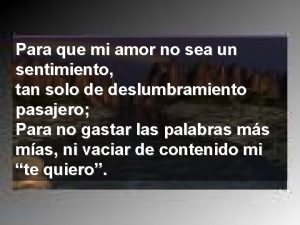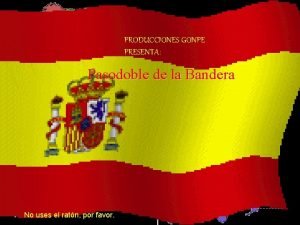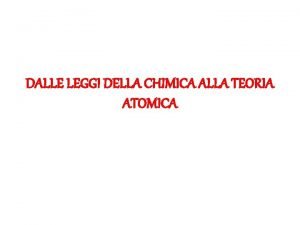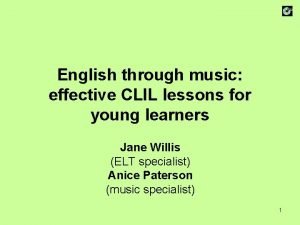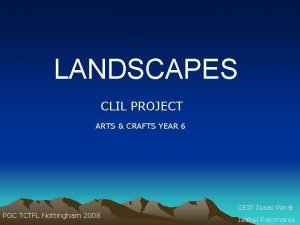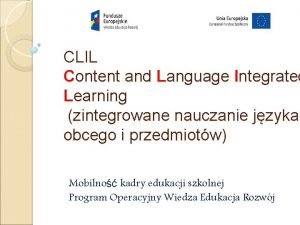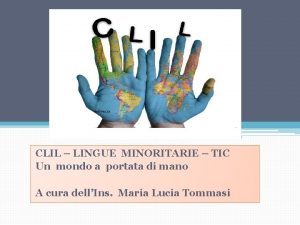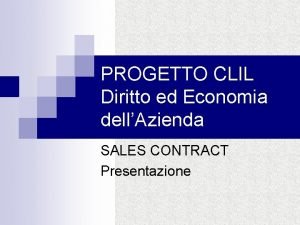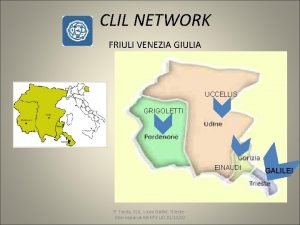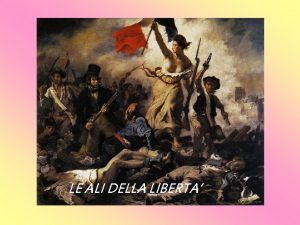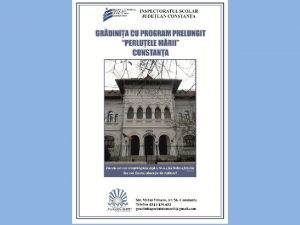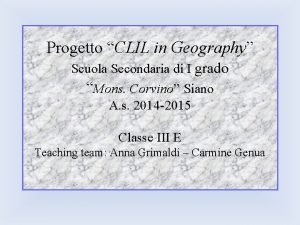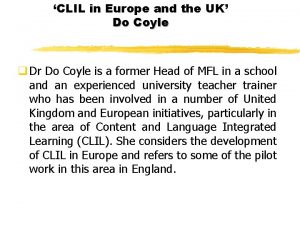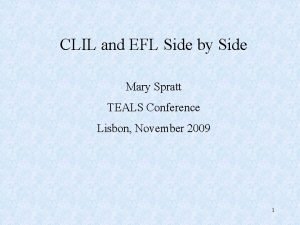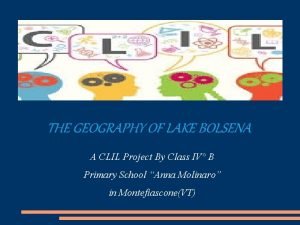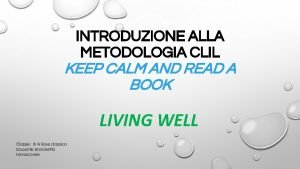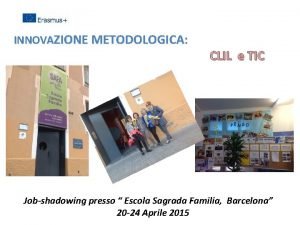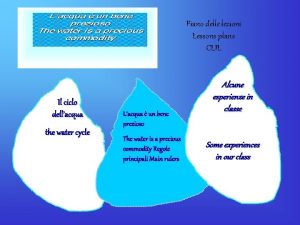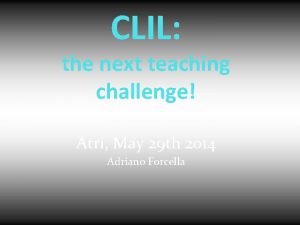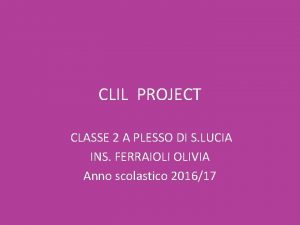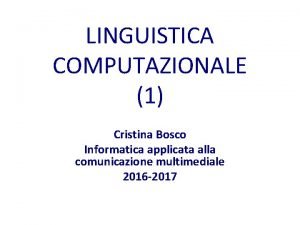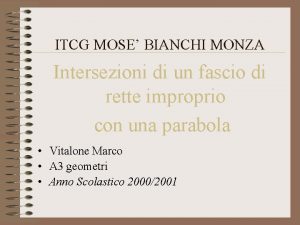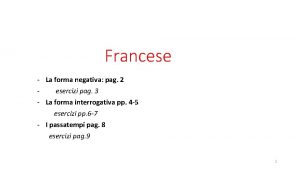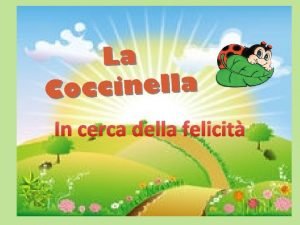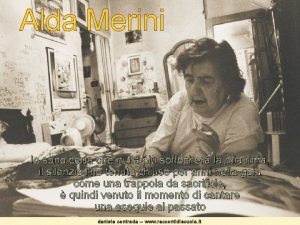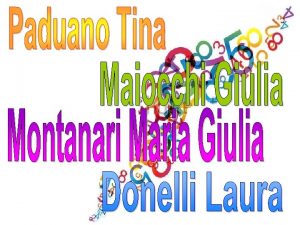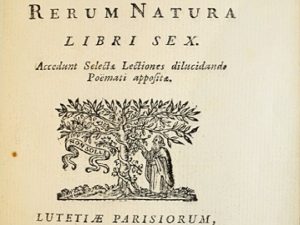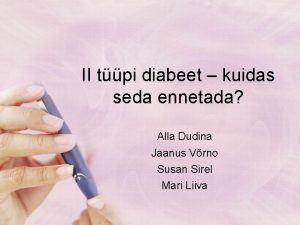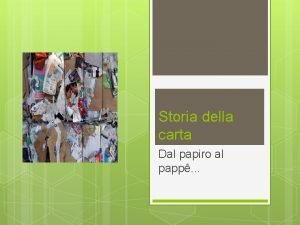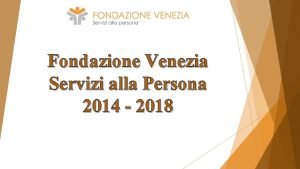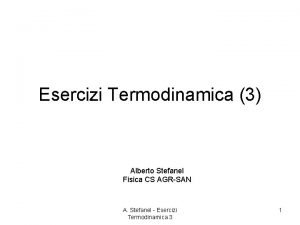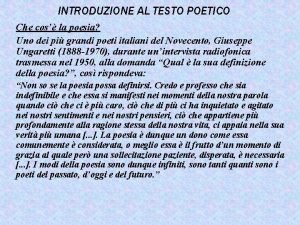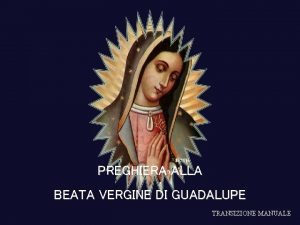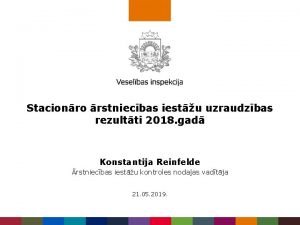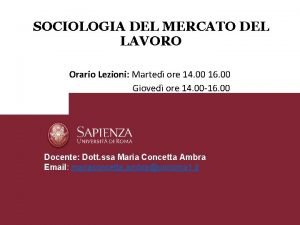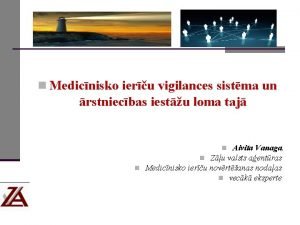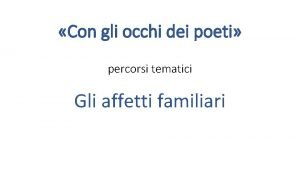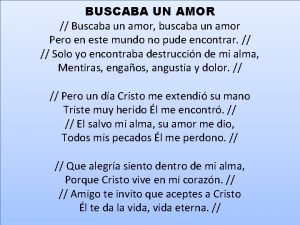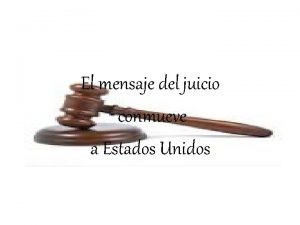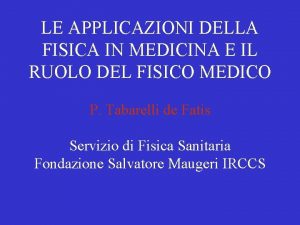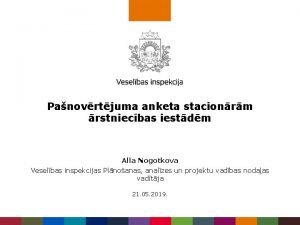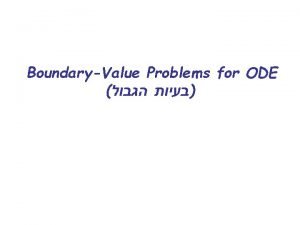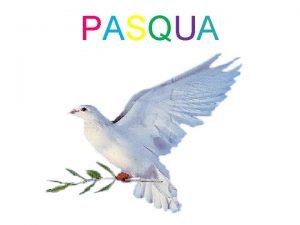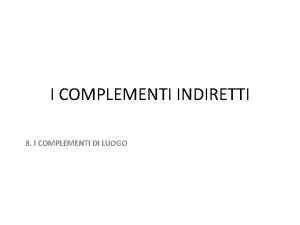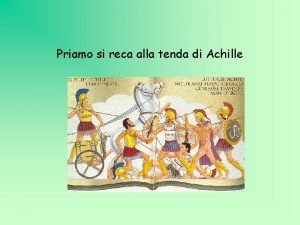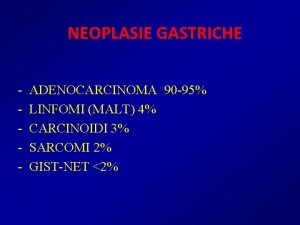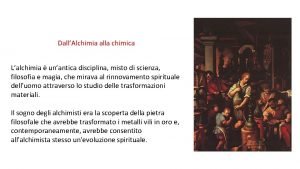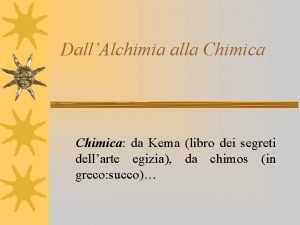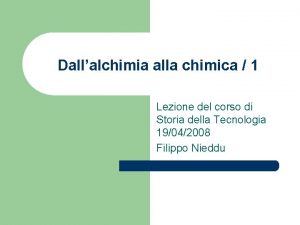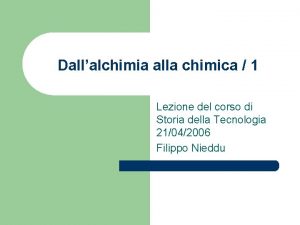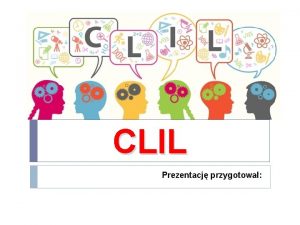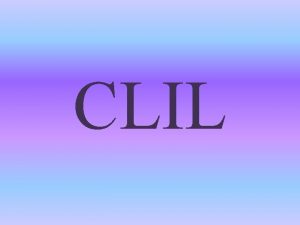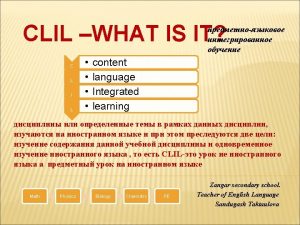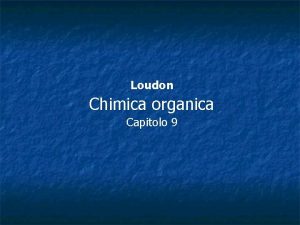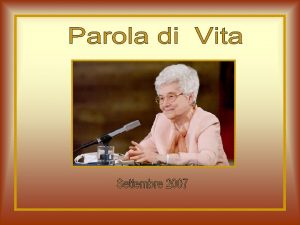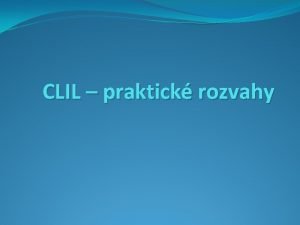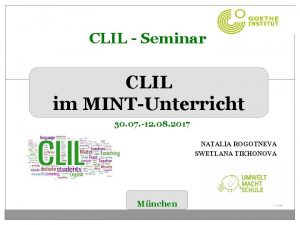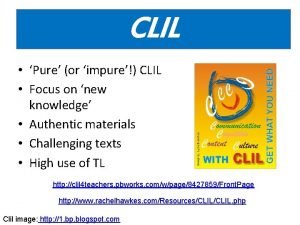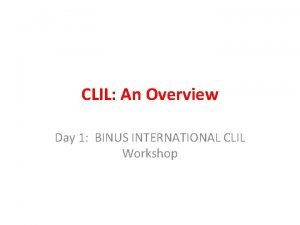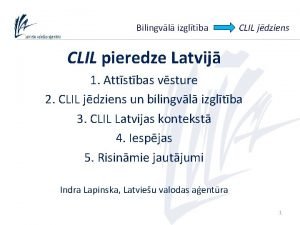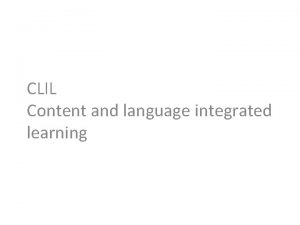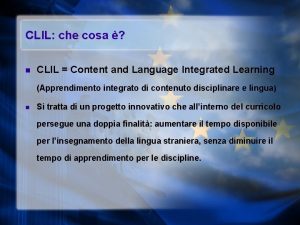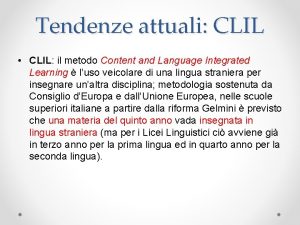CLIL RT DALLALCHIMIA ALLA CHIMICA NELLARTE I I































































- Slides: 63

CLIL @RT. DALL’ALCHIMIA ALLA CHIMICA NELL’ARTE I. I. S. S. “ROSINA SALVO” –Trapani Prof. Elena Caruso Prof. Gianfranco Naso Prof. M. Francesca Scalisi CLASSE 4 E ind. Liceo Linguistico CLASSE 4 C ind. Liceo Artistico

• Il segmento curricolare qui descritto è rivolto ad una classe quarta. • La lingua utilizzata è quella inglese; il livello di competenza linguistica QCER della classe è di tipo A 2/B 1 • Il tema scelto è stato ritenuto proficuo in quanto per la sua ricchezza si presta alla vocazione multiculturale che i docenti si sono prefissi di attivare attraverso il CLIL; inoltre esso consente espansioni, approfondimenti e collegamenti multidisciplinari grazie alla sua densa problematica. • Il Modulo avrà una durata di 4 ore da svilupparsi nel corso del 1° Quadrimestre

Activity Task 1° Vital Visual WARM UP The students are shown a picture representing a well known fresco: The Last Supper. The students will describe the picture with the help of appropriate vocabulary. TEACHER’S AIMS Time 15’ Place Language Skills Thinking Skills Tools/Devices Methodology/ strategy Language Class Speaking /Interaction Explaining Expressing ideas Interpreting Remember Explain Analyse Define Select Infer meanings from pictures Computer, LIM Activating and anchoring on prior knowledge Arouse students’curiosity Encourage peerfeedback and peerteaching. For describing Learners will acquire some fundamental words for describing pictures Learners will be familiar with the linguistic function: describing a picture This picture is used as it represents a well known fresco. The objective is to to raise the interest on the topic The students will acquire competences in describing pictures After having shown the slide 4 representing The Last Supper the teacher shows the slide 5 which contains the basics for describing pictures Three or four students will be asked to describe the picture by using the given words The teacher checks encouraging the oral expression and providing unknown words PROCEDURE GLOSSARY discepolo: disciple; scodella: bowl; piatto: plate; tavolo: table; paesaggio: landscape; pittura: painting; affresco: fresco; tovaglia: tablecloth



Activity Task 2 Speaking/Interacting: The students will answer some questions about five pictures representing frescoes in the centuries TEACHER’S AIMS Time 25’ Place Language Skills Thinking Skills Tools/Devices Methodology/ strategy Language Class Speaking/Interaction Explaining Expressing ideas Interpreting Explain Analyse Predict Define Select Infer meanings from pictures Compare and contrast Computer LIM copybooks Activating and anchoring on prior knowledge Arouse students’curiosity Encourage peerfeedback and peerteaching Facilitate comprehension through images Group work For Giving opinions, making hyphotesis, describing pictures Learners will know some information about some remarkable frescoes: their name, location, author, date of production…. . Learners will know the name of famous artists Learners will know about the fundamental information to give in describing and analysing frescoes Some significant images are shown on the LIM to promote thinking through these pictures. The questions are meant to raise the interest on the topic The students use their previous knowledge and English knowledge Let students: SPEEK FREELY ABOUT THE PICTURES SHARE IDEAS AND OPINIONS Compare and contrast pictures PROCEDURE Students are split in groups of four, and asked “what are these pictures? / Try to answer these questions Each group, after having discussed in English, has to write their own answers on their copybooks Ask students to share opinions with the other groups

Picture 1 What is it? Who is the author? When was it made? Where is it located? What does it represent? Is it a mural painting? How is called this technique of mural painting?

Picture 2 What is it? Who is the author? When was it made? Where is it located? What does it represent? Is it a mural painting? How is called this technique of mural painting?

• • • Picture 3 What is it? Who is the author? When was it made? Where is it located? What does it represent? How was it made? Is it a mural painting? How is called this technique of mural painting?

• • • Picture 4 What is it? Who is the author? When was it made? Where is it located? What does it represent? How was it made? Is it a mural painting? How is called this technique of mural painting?

Picture 5 What is it? Who is the author? When was it made? Where is it located? What does it represent? How was it made? Is it a mural painting? How is called this technique of mural painting?

Activity Task 3° Cloze test Matching Rearranging sentences Time 35’ Place Language Skills Class Reading Writing Speaking Tools/Devices Methodology/ strategy Language Analyse Select Organising Reasoning Evaluating Recognise Computer, LIM Dictionary Copybooks Activating Selecting interpreting Language of learning: vocabula ry, structures Let the students acquire a certain knowledge about some well-known frescoes Let the students choose a suitable and appropriate lexicon in describing frescoes TEACHER’S AIMS 2. 3. 5. PROCEDURE Thinking Skills 1. The slides 13 -14 -15 -16 -17 are shown on the LIM For each slide the students have to do the exercises writing the keys on their copybooks Students can work in pairs to share opinions and to discuss how to complete the writing frames 4. After having discussed the learners complete the writing task(s) At the end of the time required the teacher will provide the keys of the text(s) by using the LIM (slide 18) 6. THE STUDENTS CHECK THEIR OWN ANSWERS 7. SELF ASSESSMENT

Picture 1 Cloze test Read the text below and fill in the missing words given below in scrambled order preserves fish graffiti prehistory ritual year hunting figures Island The Cave of Genovese is on the 1)………………. . of Levanzo. The cave 2)……. . . a very important documentation of 3)……………. . in Sicily and date around the 4)……………… 9230 BC. Engravings, 5)………………. and painted male and female human 6)……………… along with mammals and 7)…………including tuna. It remains obscure whether it is a 8)…………… dance or a prayer before 9)…………

Picture 2 Match the two halves to make complete sentences • 1. The Cave of Altamira is located • 2. The numerous parietal cave paintings • 3. These drawings and paintings were created • 4. The earliest paintings in the cave • 1/……. • 2/……. . • 3/……. . • 4/……… • A)represent charcoal drawings and polychrome paintings of contemporary local fauna • B)were executed around 35, 600 years ago • C)during the Upper Paleolithic by human settlers • D)near the historical town Santillana del Mar, Spain

Picture 3 • Rearrange the following sentences to make a complete text • A) The scene takes place in front of two rocky hills, on whose peaks two different types of architecture rise up: the walls of the city of Assisi and a cloister. • B)This fresco was painted between 1297 -1300. • C) St. Francis Giving His Mantle to a Poor Man is the second of the twenty-eight scenes of the Legend of Saint Francis in the Upper Church of the Basilica di San Francesco in Assisi. • D) Francis hands his valuable golden cloak to an impoverished citizen. • The sequence is: …………………. . /………………………/……………/

Picture 4 Match the two halves to make complete sentences • 1. In 1508 Michelangelo was asked by the Pope Julius II a)creating one of the greatest world heritage of all the time • 2. The work should be enormous: a surface of 800 b)to paint the vault of Sistine Chapel in Rome • 3. He worked only four years, completely alone, c)square metres to fresco with history from the Old Testament, Sibyls and Prophets • 1/……. • 2/……. . • 3/……. .

Picture 5 Cloze test Read the text below and fill in the missing words given below in scrambled order 1. death 2. mural 3. figures 4. vivid 5. created 6. social 7. street 8. expressing 9. responded 10. messages «WE ARE THE YOUTH» IS A PAINTED WALL 1)……………………. IN ELLSWORTH STREETS IN PHILADELPHIA 2)………………. BY THE AMERICAN ARTIST AND 3)……………………… ACTIVIST KEITH ALLEN HARING IN 1987. HARING’S WORKS 4)……………………. TO THE NEW YORK CITY 5)……………………. . CULTURE OF THE 1980 s BY 6)………………. CONCEPTS OF BIRTH, 7) ………………. . , SEXUALITY AND WAR. THE BOLD LINES, 8)…………………COLORS AND ACTIVE 9)……………………CARRY STRONG 10)……………… OF LIFE AND UNITY.

KEYS • Picture 1 Cloze test. Read the text below and fill in the missing words given below in scrambled order • 1)island -2)preserves- 3)prehistory- 4)year- 5)graffiti- 6) figures- 7) fish – 8)ritual – 9)hunting • Picture 2. Match the two halves to make complete sentences • 1/E; 2/A; 3/D; 4/B • Picture 3. Rearrange the following sentences to make a complete text • The sequence is: C/B/D/A/ • Picture 4. Match the two halves to make complete sentences • 1/B; 2/C; 3/A • Picture 5. Cloze test. Read the text below and fill in the missing words given below in scrambled order • 1)mural; 2)created; 3)social; 4)responded; 5)street; 6)expressing; 7)death; 8)vivid; 9)figures; 10)messages

Activity Task 4° Fill in Time 15’ Place Language Skills Thinking Skills Tools/Devices Methodology/ strategy Language Class Writing Organising Recall Evaluating Inferring Compare and contrast Remembering Reporting back LIM Handout Activating Summarising Organising Classifying Applying previous information For classifying Let students acquire the information given Let the students develop their written competences IT CAN BE USED AS A WRITTEN TEST TEACHER’S AIMS 1. 3. PROCEDURE Each student is given a handout with a grid to complete 2. Students work individually to complete the grid The keys are given and the students check their answers by themselves 4. Self assessment

FILL IN THE GRID WHO WHERE WHEN WHAT

Procedure First Lesson Activity Task 5° Role-play Oral production Time 25’ Language Skills Thinking Skills Tools/Devices Methodology/ strategy Language Class Speaking/interaction Organising Expressing Reporting Explain LIM Handout Discussing Interpreting Summarizing Describing Recalling information For Describing, Giving information Let students develop their oral fluency Let the students acquire information about famous frescos TEACHER’S AIMS 2. 3. PROCEDURE Place 1. By using the information they have got the students are asked to roleplay an interview about every fresco The students are working into pairs: one is the interviewer, the other is an Art Teacher who has to explain these famous works. Another student has to check the answers given by filling an evaluation grid that the students have already developed and used IT CAN BE USED AS AN ORAL TESTING 1. An example of the grid is given in slide 22

Name……………. Group……………. Date………………. A) Fluency A) Communicative ability A) Accuracy/ Grammar A) Vocabulary A) Pronunciation A) Content Suitable speed, pauses, discourse strategies Lenght of utterances Complexity of responses Use of verbs, sentence structure, functional phrases Variety of words and phrases, new vocabulary Intonation, stress Topic elaboration, organization, linkers and connectors 0. 1. 2. 3 0. 1. 2. 3

Procedure First Lesson Activity Task 6° Reading comprehension Matching questions/answers Video watching TEACHER’S AIMS Time 25’ Place Language Skills Thinking Skills Tools/Devices Methodology/ strategy Language Class Reading Listening Skimming Scanning Organising Selecting Understanding LIM Handout Dictionary Copybooks Interpreting Synthesizing Inferring Rearranging For understanding Let students acquire the basic knowledge about the fresco technique Let the students acquire basic lexicon about frescoes The students are allowed to use a dictionary PROCEDURE 1. The students individually read the text silently 2. The teacher asks to one/two students to sum up orally about the general content of the text 3. A second reading follows. Now the students have to answer some questions (slide 25) 4. To check their comprehension the right answers are given in scrambled order (slide 26) 5. The students have to rearrange them by writing them on their copybooks 6. Now the students are ready to watch a video from Youtube about the fresco technique. (slide 27)

• While the art of fresco painting reached its peak during the Italian Renaissance, examples of painting on wet plaster date back to 1500 B. C. , and fresco paintings in caves were done more than 15, 000 years ago. • Frescoes were used for many large-scale works during the Renaissance, such as the ceiling of the Sistine Chapel. • To achieve a buon or "true" fresco, artists use pure pigments and water to paint on wet plaster. Through this technique, the painting becomes part of the plaster wall or ceiling. An artist needs to work quickly and carefully while painting a true fresco because it cannot be changed once it dries. Several layers of plaster are applied to the wall or ceiling before the final painting layer is done. • Since plaster dries quickly, it was important for artists to work on a buon fresco in small sections. To make it easier, artists planned drawings of their work, called cartoons. After poking holes along the outline of a cartoon, an artist would hold it up to the wet plaster and apply a colored dust, such as charcoal, through the holes. This transferred the outline of the drawing on to the wet plaster. This technique is called Pouncing. • Alternately, artists could use a metal point to lightly indent the outline of the cartoon into the wet plaster.

ANSWER THE FOLLOWING QUESTIONS • 1. When can be found the first examples of fresco painting? • 2. How could artists make a buon fresco? • 3. Why an artist had to work quickly when making a fresco? • 4. What were the cartoons? • 5. How could the drawing in the cartoon be transferred on the wet plaster? • 6. Which other method could be used to transfer the drawing in the cartoon on the wet plaster?

MATCH THE FOLLOWING ANSWERS TO THE APPROPRIATE QUESTIONS • 1. They were drawings of the artist’s work • 2. First the artist poked holes along the outline of the drawing in the cartoon, after this cartoon was put on the wet plaster and, through the holes, charcoal was applied. This method transferred the outline of the drawing on the wet plaster. • 3. A metal point could be used to indent the outline of the cartoon into the wet plaster • 4. They used pure pigments and water to paint on wet plaster • 5. He had to be quick because he couldn’t change the fresco if it dried • 6. They can be found more than 15, 000 years ago

• /www. youtube. com/watch? v=Cej 4 Ggq 5 n. QI

Activity Task 7° Reading comprehension TEACHER’S AIMS Time 15’ Place Language Skills Thinking Skills Tools/Devices Class Reading Interpreting Arranging Selecting Inferring LIM Copybooks Methodology/ strategy Interpreting Synthesizing Inferring Predicting Cooperative learning Let students acquire the basic knowledge about the various stages in the making of a fresco Let the students acquire basic lexicon about how to make a fresco A text about the various stages in the making of a fresco is shown on the LIM If necessary the new words can be explained with the help of some pictures The students , in pairs, have to read the text silently trying to understand the meaning. To check comprehension a multiple choice exercise will follow (slide 30) THIS CAN BE USED AS A WRITTEN TESTING PROCEDURE Language For understanding

How to make a fresco On the wall are laid in succession by using a trowel: – Rinzaffo (raw mortar made of rough sand, water and lime) – Arriccio (mortar made of fine sand, water and lime) –Tonachino or intonachino (mortar made of fine sand, marble powder, lime and water) – Painting (pigments dissolved with water).

Tick which answer A, B, C best fits each sentence . 1 The rinzaffo is made of: A. Raw mortar made of lime, plaster and water B. Raw mortar made of water, lime and rough sand C. Raw mortar made of water, lime and marble powder 2. A layer of raw mortar is generally put A. At the beginning B. At the end C. None of the above 3. Arriccio is applied A. After the rinzaffo B. At the end C. Before the rinzaffo 4. What are the stages in making a fresco? A. Pigments, intonaco plaster, arriccio, rinzaffo B. Rinzaffo, arriccio, intonaco plaster, pigments C. Intonaco plaster, arriccio, pigments, rinzaffo

Activity Task 8° Reading comprehension Matching questions/answers Class discussion TEACHER’S AIMS PROCEDURE Time 25’ Place Language Skills Thinking Skills Tools/Devices Methodology/ strategy Language Art Room Reading Understanding Organising Interpreting Organising Inferring Making hypothesis Analysing Evaluating LIM Computers Copybooks Dictionary Interpreting Synthesizing Inferring Comparing ideas Arranging Cooperative learning Take active part in a lesson Self assessment For describing Let students acquire the basic knowledge about the most common pigments and binders Let the students acquire basic lexicon about pigments and binders The first step of the lesson is to provide a definition of what are pigments and binders. This definition is given in slide 33. The students read this definition silently trying to understand the text with the help of online dictionaries If they ask, the Art teacher can help them by giving some explanations The slides 34, 35, 36 are given to help comprehension Slide 37 is now shown to the students. They have to rearrange by matching the name of the pigment with its definition. The students are grouped into groups of five and they are using their copybooks. At the end a student for each group has to give the keys of the exercise trying to motivate the choices. The key is given (slide 38) and the students check their own answers. The Art Teacher has put some jars containing some pigments on a table Now the students have to stick appropriate labels of the names of the pigments to the jars.

PIGMENTS AND BINDERS

• Pigments are very fine powder that have their own colour, and they are colour material for paint. • Paints are mainly made of pigments and binders. • The binders hold the pigments. • Tempera (from Latin=temperare=to mix) is traditionally created by hand-grinding dry powdered pigments into a binding agent such as: egg white, egg yolk, milk (in the form of caseine) and a variety of plant gums.

PIGMENTS Yellow Ochre Red Ochre (or Red Earth) Burnt Siena Vandyke Brown

Bremer Blue Cobalt Green Titanium White

BINDERS • EGG YOLK • EGG WHITE • PLANT GUMS • MILK IN THE FORM OF CASEINE

MATCH THE NAMES WITH THE DEFINITION Pigments Definitions Vandyke Brown It is of mineral origin. The main colour giving component is the mineral called Limonite Cobalt Green It is of mineral origin. The main colour giving component is the mineral called Hematite. It can be obtained from the Hematite or by calcination of Yellow Ochre. Titanium White It is of mineral origin. The main colour giving component is the mineral called Iron Oxide. It is made by calcination of the pigment Row Siena. Yellow Ochre It is an organic natural pigment consisting of materials found in brown coal. It is made by grinding and washing the Lignite. Bremer Blue It is an inorganic chemical. It is the basic copper-carbonate and is the artificial form of the pigment azurite. It was invented by Peligot in 1858. Red Ochre (or Red Earth) It is an inorganic chemical. It is a mixed oxide of cobalt and zinc. Burnt Siena It is a synthetic mineral inorganic pigment. It is obtained from Ilmenide by Titanium extraction.

KEYS Pigments Definitions Yellow Ochre It is of mineral origin. The main colour giving component is the mineral called Limonite Red Ochre (or Red Earth) It is of mineral origin. The main colour giving component is the mineral called Hematite. It can be obtained from the Hematite or by calcination of Yellow Ochre. Burnt Siena It is of mineral origin. The main colour giving component is the mineral called Iron Oxide. It is made by calcination of the pigment Row Siena. Vandyke Brown It is an organic natural pigment consisting of materials found in brown coal. It is made by grinding and washing the Lignite. Bremer Blue It is an inorganic chemical. It is the basic copper-carbonate and is the artificial form of the pigment azurite. It was invented by Peligot in 1858. Cobalt Green It is an inorganic chemical. It is a mixed oxide of cobalt and zinc. Titanium White It is a synthetic mineral inorganic pigment. It is obtained from Ilmenide by Titanium extraction.

Activity Task 9° Rearrange a given text TEACHER’S AIMS Time 15’ Place Language Skills Thinking Skills Tools/Devices Methodology/ strategy Language Class Speaking/Interacting Reading Analysing Interpreting Describing Discussing Skimming Scanning Organising Selecting Explaining Showing and telling Online dictionary LIM Interpreting Synthesizing Inferring Comparing ideas Arranging Cooperative learning For describing This activity is meant to introduce the students to the frescoes in the Cave of Santa Margherita in Castellammare. The students will acquire some specific words linked to the general topic Some pictures of the frescoes in the Cave of Santa Margherita are shown on the LIM. A general conversation starts where the students will be asked to make predictions about these pictures. . This activity lasts no more than 5 minutes. Sample questions: 1. What is it? 2. What can you see in this pictures? 3. Why is so difficult to see these images? The students are now grouped into groups of three and they will be given a text about the cave. Each group has to rearrange it. (slide 42). The students can use online dictionaries PROCEDURE At the end of the activity, one student for each group will give the keys of the exercise trying to motivate the choices. In the end the key is given (slide 43) and the students can check their own answers.



Rearrange the following text: The paintings of the cave of Saint Margaret at Castellammare del Golfo. A) On the original marine creature, which extends horizontally along the wall, there were probably superimposed, at different moments, some figures made on a white background squared off in red and framed inside in yellow. B) On the opposite wall there is a Crucifixion and traces of other figures C) Salts, mosses, humidity, as well as the general poor state of conservation, have so corrupted the pictorial surface that, in many places, it has fallen completely and the iconographic recognition of these figures is not possible. D) One of these figures is the supposed St. Margaret of Antioch, the other figures are probably: a Virgin Eleusa, a bearded Saint with a book and another unidentified character. E) A few kilometers away from Castellammare in a rocky cliff overlooking the sea there is a cave, which was probably used as a place of worship. There are some frescoes inside the cave. F) Entering the cave, the visitor's attention is immediately captured by a large pictorial group on the right. It lies in a privileged and well-lit position and consists of a wide, elongated figure of a sea monster of which only the disturbing head remains; it is datable within the time span ranging from XIII to XV century. G) It is possible to suppose that this representation had the apotropaic function to protect the fishermen against the sharks. The right sequence is: …. . /…. /…. /…. /

The paintings of the cave of Saint Margaret at Castellammare del Golfo. A few kilometers away from Castellammare in a rocky cliff overlooking the sea there is a cave, which was probably used as a place of worship. There are some frescoes inside the cave. Entering the cave, the visitor's attention is immediately captured by a large pictorial group on the right. It lies in a privileged and welllit position and consists of a wide, elongated figure of a sea monster of which only the disturbing head remains; it is datable within the time span ranging from XIII to XV century. It is possible to suppose that this representation had the apotropaic function to protect the fishermen against the sharks. On the original marine creature, which extends horizontally along the wall, there were probably superimposed, at different moments, some figures made on a white background squared off in red and framed inside in yellow. One of these figures is the supposed St. Margaret of Antioch, the other figures are probably: a Virgin Eleusa, a bearded Saint with a book and another unidentified character. On the opposite wall there is a Crucifixion and traces of other figures. Salts, mosses, humidity, as well as the general poor state of conservation, have so corrupted the pictorial surface that, in many places, it has fallen completely and the iconographic recognition of these figures is not possible.

Activity Task 10° Cloze text TEACHER’S AIMS Time 15’ Place Language Skills Thinking Skills Tools/Devices Methodology/ strategy Language Class Speaking/Interacting Reading Analysing Interpreting Describing Discussing Skimming Scanning Organising Selecting Explaining Showing and telling Arranging Selecting Inferring Online dictionary LIM Interpreting Synthesizing Inferring Comparing ideas Arranging Cooperative learning For describing Let the students be conscious of the problems linked to the restoration of a work of art Let the students acquire the basic knowledge about restoration and its phases. Let the students know some specific words linked to the general topic After having introduced the frescoes in the cave of Santa Margherita in Castellammare the students will be asked to reflect on the many issues linked to the restoration. For this purpose some questions will be written on the LIM (slide 44) and a class discussion will follow (10 minutes) After that the students will be asked to do an activity (slide 45) PROCEDURE The students are grouped into groups of three and they will be given a handout with the exercise Each group has to fill in the missing words in the text To facilitate the students in their process of understanding the text has been divided into three parts A) B) C) The students can use online dictionaries At the end of the activity, one student for each group will give the keys of the exercise trying to motivate the choices. In the end the key is given (slide 48) and the students can check their own answers.

ANSWER THE FOLLOWING QUESTIONS Look carefully at the pictures. • Is it easy to understand that this is Santa Margherita? • What colours are still visible? Where? • What would be the procedure for retrieving the image? • Why is it difficult to read the picture? • In your opinion, what this degradation is due to?

Cloze test Read the text below and fill in the missing words given below in scrambled order ADHESION ARTWORK INTERVENTIONS PRESERVE PREVENT MATERIALS A) The conservation is designed to 1)………… as much original finish and 2)…………… as possible. It is especially important to 3)………………. any colour gaps in 4)………………, whether painted or sculpted. 5)…………… with protective products or on the 6)………………and homogeneity between different parts of the artwork.

PRESERVED HEALTHY DETRIMENTAL MOVED LOCATED FUTURE • B)The preservation • If the environment in which a work of art is 1)…………is considered too aggressive and 2)…………. . to its state of conservation, it can be 3)…………into a more 4)…………………. environment where it can be 5)……………in the best way for 6)………………generations.

COLOUR PARTS REINTEGRATION CONSERVATION C) The aesthetic restoration is the pictorial 1)…………. of the missing 2)…………. . both in the design and the 3)……………. It is more extreme than simple 4)……………

KEYS • A) 1. PRESERVE; 2. MATERIALS; 3. PREVENT; 4. ARTWORK; 5. INTERVENTIONS; 6. ADHESION • B) 1. LOCATED; 2. DETRIMENTAL; 3. MOVED; 4. HEALTHY; 5)PRESERVED; 6. FUTURE • C) 1. REINTEGRATION; 2. PARTS; 3. COLOUR; 4. CONSERVATION.

Activity Task 11° Rearrange a given text Matching TEACHER’S AIMS Time 20’ Place Language Skills Thinking Skills Tools/Devices Methodology/ strategy Language Class Reading Analysing Interpreting Describing Discussing Making hypothesis Inferring Skimming Scanning Organising Selecting Explaining Showing and telling Online dictionary LIM Interpreting Synthesizing Inferring Comparing ideas Arranging Cooperative learning For describing Let the students be conscious of the steps in the process of restoration Let the students acquire the basic knowledge of the steps in the process of restoration. Let the students know some specific words linked to the general topic After having analysed the pictures in the cave of Santa Margherita in Castellammare the students will be asked to reflect on the steps in a restoration process. The various stages in the restoration of wall paintings are given in scrambled order (slide 51) The students, grouped into three, have to rearrange these steps After having done this activity the students have to match each phase with its description ( slide 52) The students can use online dictionaries At the end of the activity, one student for each group will give the keys of the exercise trying to motivate the choices. At the end the full text is given (slide 53) and the students can check their answers PROCEDURE

THE INTERVENTION PHASES IN THE RESTORATION OF WALL PAINTINGS GIVE THE RIGHT SEQUENCE OF THE PHASES IN THE RESTORATION OF WALL PAINTINGS Pictorial reintegration 1. Preliminary investigations 2. Filling 3. Cleaning 4. Consolidation 5. Security preliminary operations 6.

MATCH EACH PHASE WITH ITS DESCRIPTION 1. Preliminary investigations A. It is aimed at removing foreign substances generating further degradation without affecting the original material 2. Security preliminary operations B. It is aimed at returning cohesion to material that is altered due to degradation processes 3. Cleaning C. The entire surface is consolitated with the aim of restoring structural continuity and making the surface more stable and readable 4. Consolidation D. It is used to restore an appropriate reading of the artwork through the colour connection 5. Filling E. Historical investigation Visual survey Diagnostic investigation 6. Pictorial reintegration F. Securing the parts of detached plaster through protective coating with one or more layers of gauze or special paper.

THE INTERVENTION PHASES IN THE RESTORATION OF WALL PAINTINGS 1. Preliminary investigations: Historical investigation Visual survey Diagnostic investigation 2. Security preliminary operations Securing the parts of detached plaster through protective coating with one or more layers of gauze or special paper. 3. Cleaning It is aimed at removing foreign substances generating further degradation without affecting the original material 4. Consolidation It is aimed at returning cohesion to material that is altered due to degradation processes. 5. Filling The entire surface is consolitated with the aim of restoring structural continuity and making the surface more stable and readable 6. Pictorial reintegration It is used to restore an appropriate reading of the artwork through the colour connection

Activity Task 12° TESTING Drawing Painting Oral production TEACHER’S AIMS Time 30 Place Language Skills Thinking Skills Tools/Devices Methodology/ strategy Language Art class Speaking Reporting Discussing Showing and telling Online dictionary paper, brushes, egg -tempered colors, watercolor, Cooperative learning Of describing For giving opinions CLASS TEST THIS TEST IS MEANT TO EVALUATE STUDENTS’ DRAWING SKILLS AND ORAL PRODUCTION IN L 2 Let the students reproduce a possible restoration of a detail of the frescoes of Santa Margherita and expose this process in L 2 Students are divided into groups of three and are asked to draw a detail of Santa Margherita frescoes and paint them with a pictorial technique: egg tempera, watercolor and fresco. Each group must create a pictorial work that expresses a creative solution for a hypothetical pictorial restoration. Eventually the students will report about the pictorial solution and its motivations THE GRIDS ARE GIVEN (SLIDES 55 -56) PROCEDURE

GRIGLIA DI VALUTAZIONE DISCIPLINA: DISEGNO VOTO 1/2 3 COMPETENZE Scarse o parziali Lacunose CONOSCENZE Nessuna Gravissimi errori CAPACITA’ Scarse o parziali Scadente manualità grafica, disordine e grave imprecisione 4 Carenti Gravi errori Forti imprecisioni grafiche, scorretta impostazione esecutiva nell’uso della tecnica pittorica 5 Superficiali, generiche e non sempre corrette. Minime, incomplete e con errori Imprecisione grafica, uso non sempre corretto delle indicazioni nell’impostazione esecutiva 6 Semplici, ma essenziali su tutti i contenuti. Semplici ma coerenti. Accettabile impostazione grafica e applicazione delle indicazioni esecutive in merito alla tecnica pittorica 7 Complete Corrette e complete anche se con qualche imperfezione Buona impostazione grafica, uso corretto delle indicazioni pittorica, delle rilevazioni volumetriche con ordine e precisione 8 Complete e sicure Autonome, corrette e complete Autonomia e creatività nell’impostazione grafica e nell’applicazione delle indicazioni esecutive Autonome, sicure, corrette e complete Proprietà esecutiva e ricercatezza creativa grafica e chiaroscurale, nell’impostazione e nell’applicazione delle indicazioni 9 Complete, approfondite e ben articolate 10 Complete, approfondite, ampliate e Personali, autonome, personalizzate. sicure, corrette e complete Elaborazione autonoma personale con padronanza e precisione grafica e pittorica

ORAL PRODUCTION A) Fluency A) Communicative ability A) Accuracy/ Grammar A) Vocabulary A) Pronunciation A) Content Suitable speed, pauses, discourse strategies Lenght of utterances Complexity of responses Use of verbs, sentence structure, functional phrases Variety of words and phrases, new vocabulary Intonation, stress Topic elaboration, organization, linkers and connectors 0. 1. 2. 3 0. 1. 2. 3

Activity Task 13° TESTING Written production TEACHER’S AIMS Time 30’ Place Language Skills Thinking Skills Tools/Devices Methodology/ strategy Art class Writing Summarising Paragraphing Recalling Remembering Reporting back Handout Activating Organising Classifying Applying previous information CLASS TEST THIS TEST IS MEANT TO EVALUATE STUDENTS’ CONTENT AND LANGUAGE COMPETENCES A handout is given to the students (SLIDE 59) Students work individually THE EVALUATION GRIDS ARE GIVEN (SLIDES 60 -61) PROCEDURE Language

TEST DI VERIFICA FINALE Answer the following questions (max. 5 lines) 1. How would you define the fresco technique using a suitable terminology? 2. Can you identify the main pigments used to make a fresco and describe their features? 3. Can you identify the main binders used in the various pictorial techniques? 4. Based on what you know, write about the cave of Santa margherita, indicating the location and the iconographic features inherent to the figure of the saint. 5. Explain about the state of preservation of the fresco depicting Santa Margherita 6. Write about the operational phases of pictorial restoration 7. Based on what you know about the restoration methodologies, propose that, in your opinion, most appropriate for the fresco depicting Santa Margherita

• GRIGLIA DI VALUTAZIONE ARTE Nulla Gravemente insufficiente Insufficiente Sufficiente Discreta Buona Ottima 1 2 2. 5 3 3. 5 4 5 PROPRIETA’ E CHIAREZZA ESPRESSIVA. USO DEL LINGUAGGIO SPECIFICO 0. 5 1 1. 25 1. 75 2 2. 5 CAPACITA’ DI CONTESTUALIZZARE E STABILIRE COLLEGAMENTI 0. 5 1 1. 25 1. 75 2 2. 5 ARTE CONOSCENZA E COMPLETEZZA DEI CONTENUTI TOTALE Voto

CRITERI DI VALUTAZIONE PER LA PROVA DI LINGUA STRANIERA Produzione scritta CRITERI CONTENUTI DESCRITTORI Pertinenza, original ità, trattazione esaustiva dell’argomento, coerenza delle argomentazioni. LIVELLO MORFOSINTATTICO ED USO DEI REGISTRI Correttezza morfo -sintattica ed ortografica ; registro adeguato. FORMA E LESSICO Espressione chiara, scorrevole; lessico ricco ed appropriato. Approccio critico; argomentazione personale RIELABORAZIONE CRITICA TOTALE…………………. /20 MEDIOCRE DISCRETOOTTIMO ECCELLENTE 3 4 5 2, 5 3 4 5 2 2, 5 3 4 5 INSUFFICIE NTE SCARSO 1 2 2, 5 1 2 1 1 SUFFICIENTE

• Per la riflessione e la valutazione finale si propone agli studenti un questionario sul grado di apprezzamento del modulo. • QUESTIONARIO PER GLI STUDENTI • SCHEDA PER LA VALUTAZIONE DEL MODULO E PER LA AUTOVALUTAZIONE DELLE CONOSCENZE E DELLE COMPETENZE ACQUISITE NEL MODULO CLIL • QUESTIONARIO PER GLI STUDENTI • NOME………………. 1. Ritieni la modalità operativa • Noiosa • Utile • Motivante • Inutile • Altro…………… 2. Ritieni il tema trattato • Interessante • Noioso • Poco motivante • Complesso • Altro………………. 3. Ritieni l’impegno richiesto nelle attività • Superiore a ciò che ti aspettavi • Accessibile • Ho messo poco impegno • Ho messo molto impegno • Altro………

4. Ritieni il rapporto con i docenti • Di facilitazione • Di guida • Di controllo • Non importante • Altro………. 5. Ritieni il tuo rapporto con gli altri studenti • Rispettoso • Collaborativo • Non costruttivo • Poco necessario • Altro………. . 6. Ritieni questo nuovo ambiente di lavoro CLIL • Gratificante • Sereno • Inutile • Poco motivante • Altro……. . 7. Ritieni il tuo ruolo all’interno dell’ambiente CLIL • Ricettivo • Produttivo • Interattivo • Poco produttivo • Altro……………

8. Ritieni il rapporto tra L 2 storia dell’arte • Paritario • Più enfasi nella L 2 • Più enfasi in storia dell’arte • In parte • Altro…………. 9. Hai gradito le attività svolte • Si • No
 Mas alla de mis miedos
Mas alla de mis miedos Alla por la tierra mora letra
Alla por la tierra mora letra Soluzioni chimica più verde
Soluzioni chimica più verde Chimica piu capitolo 17 soluzioni
Chimica piu capitolo 17 soluzioni Chimica più verde soluzioni
Chimica più verde soluzioni Legge proust
Legge proust Xalqaro clil metodi
Xalqaro clil metodi Clil music lesson plan
Clil music lesson plan Tctfl
Tctfl Hard clil
Hard clil Clil przykłady
Clil przykłady Tic e clil
Tic e clil Clil topics
Clil topics Tkt clil
Tkt clil Esempio di lezione clil diritto
Esempio di lezione clil diritto Metoda fonetica analitico-sintetica
Metoda fonetica analitico-sintetica Clil meaning
Clil meaning Naf unit
Naf unit The solar system clil
The solar system clil Clil grigoletti
Clil grigoletti Language
Language Clil meaning
Clil meaning Progetto clil
Progetto clil Care sunt cele 4 componente ale metodei clil
Care sunt cele 4 componente ale metodei clil Clil geography
Clil geography Clil meaning
Clil meaning Clil water
Clil water Do coyle
Do coyle Clil meaning
Clil meaning Clil geography primary school
Clil geography primary school Metodologia clil
Metodologia clil Tic e clil
Tic e clil Clil ciclo dell'acqua
Clil ciclo dell'acqua Clil meaning
Clil meaning Clil
Clil Clil showers
Clil showers Christina bosco
Christina bosco Retta esterna alla parabola
Retta esterna alla parabola Forme interrogative francese
Forme interrogative francese La storia della coccinella in cerca della felicità
La storia della coccinella in cerca della felicità I poeti lavorano di notte analisi metrica
I poeti lavorano di notte analisi metrica Equazione bisettrice 2 e 4 quadrante
Equazione bisettrice 2 e 4 quadrante De rerum natura schema
De rerum natura schema Alla dudina
Alla dudina Storia della carta
Storia della carta Fondazione venezia servizi
Fondazione venezia servizi Termodinamica
Termodinamica Il linguaggio della poesia è ricco di
Il linguaggio della poesia è ricco di Beata cirrose
Beata cirrose Alla nogotkova
Alla nogotkova Reyneri introduzione alla sociologia del mercato del lavoro
Reyneri introduzione alla sociologia del mercato del lavoro Alla nogotkova
Alla nogotkova Preghiera alla madre saba
Preghiera alla madre saba Proposizioni principali
Proposizioni principali Cuyaj dioslla punllanta
Cuyaj dioslla punllanta Figuras profeticas de daniel
Figuras profeticas de daniel Fisica in medicina
Fisica in medicina Terzo settore cos'è
Terzo settore cos'è Anketa
Anketa Ode
Ode Cosciotto di agnello alla brace
Cosciotto di agnello alla brace Complementi di luogo
Complementi di luogo Priamo nella tenda di achille
Priamo nella tenda di achille Antecolica
Antecolica
